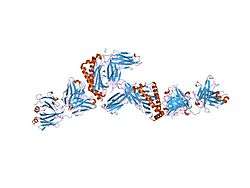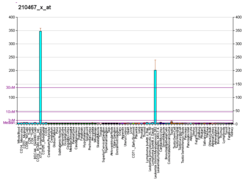Further reading
- Takahashi K, Shichijo S, Noguchi M, et al. (1995). "Identification of MAGE-1 and MAGE-4 proteins in spermatogonia and primary spermatocytes of testis". Cancer Res. 55 (16): 3478–82. PMID 7627949.
- Celis E, Fikes J, Wentworth P, et al. (1995). "Identification of potential CTL epitopes of tumor-associated antigen MAGE-1 for five common HLA-A alleles". Mol. Immunol. 31 (18): 1423–30. doi:10.1016/0161-5890(94)90158-9. PMID 7823968.
- De Plaen E, Arden K, Traversari C, et al. (1994). "Structure, chromosomal localization, and expression of 12 genes of the MAGE family". Immunogenetics. 40 (5): 360–9. doi:10.1007/BF01246677. PMID 7927540.
- Schultz-Thater E, Juretic A, Dellabona P, et al. (1994). "MAGE-1 gene product is a cytoplasmic protein". Int. J. Cancer. 59 (3): 435–9. doi:10.1002/ijc.2910590324. PMID 7927954.
- Ding M, Beck RJ, Keller CJ, Fenton RG (1994). "Cloning and analysis of MAGE-1-related genes" (Submitted manuscript). Biochem. Biophys. Res. Commun. 202 (1): 549–55. doi:10.1006/bbrc.1994.1963. PMID 8037761.
- Wang MG, Zakut R, Yi H, et al. (1994). "Localization of the MAGE1 gene encoding a human melanoma antigen to chromosome Xq28" (Submitted manuscript). Cytogenet. Cell Genet. 67 (2): 116–9. doi:10.1159/000133810. PMID 8039421.
- Becker JC, Gillitzer R, Bröcker EB (1994). "A member of the melanoma antigen-encoding gene (MAGE) family is expressed in human skin during wound healing". Int. J. Cancer. 58 (3): 346–8. doi:10.1002/ijc.2910580306. PMID 8050815.
- Gaugler B, Van den Eynde B, van der Bruggen P, et al. (1994). "Human gene MAGE-3 codes for an antigen recognized on a melanoma by autologous cytolytic T lymphocytes". J. Exp. Med. 179 (3): 921–30. doi:10.1084/jem.179.3.921. PMC 2191409. PMID 8113684.
- Chen YT, Stockert E, Chen Y, et al. (1994). "Identification of the MAGE-1 gene product by monoclonal and polyclonal antibodies". Proc. Natl. Acad. Sci. U.S.A. 91 (3): 1004–8. doi:10.1073/pnas.91.3.1004. PMC 521442. PMID 8302824.
- Rogner UC, Wilke K, Steck E, et al. (1996). "The melanoma antigen gene (MAGE) family is clustered in the chromosomal band Xq28". Genomics. 29 (3): 725–31. doi:10.1006/geno.1995.9945. PMID 8575766.
- Luescher IF, Romero P, Kuznetsov D, et al. (1996). "HLA photoaffinity labeling reveals overlapping binding of homologous melanoma-associated gene peptides by HLA-A1, HLA-A29, and HLA-B44". J. Biol. Chem. 271 (21): 12463–71. doi:10.1074/jbc.271.21.12463. PMID 8647853.
- Tanzarella S, Russo V, Lionello I, et al. (1999). "Identification of a promiscuous T-cell epitope encoded by multiple members of the MAGE family". Cancer Res. 59 (11): 2668–74. PMID 10363990.
- Mallon AM, Platzer M, Bate R, et al. (2000). "Comparative genome sequence analysis of the Bpa/Str region in mouse and Man". Genome Res. 10 (6): 758–75. doi:10.1101/gr.10.6.758. PMC 310879. PMID 10854409.
- Jang SJ, Soria JC, Wang L, et al. (2001). "Activation of melanoma antigen tumor antigens occurs early in lung carcinogenesis". Cancer Res. 61 (21): 7959–63. PMID 11691819.
- Suyama T, Ohashi H, Nagai H, et al. (2003). "The MAGE-A1 gene expression is not determined solely by methylation status of the promoter region in hematological malignancies". Leuk. Res. 26 (12): 1113–8. doi:10.1016/S0145-2126(02)00048-6. PMID 12443884.
- Strausberg RL, Feingold EA, Grouse LH, et al. (2003). "Generation and initial analysis of more than 15,000 full-length human and mouse cDNA sequences". Proc. Natl. Acad. Sci. U.S.A. 99 (26): 16899–903. doi:10.1073/pnas.242603899. PMC 139241. PMID 12477932.
- Nagao T, Higashitsuji H, Nonoguchi K, et al. (2003). "MAGE-A4 interacts with the liver oncoprotein gankyrin and suppresses its tumorigenic activity". J. Biol. Chem. 278 (12): 10668–74. doi:10.1074/jbc.M206104200. PMID 12525503.
- Zerbini A, Pilli M, Soliani P, et al. (2004). "Ex vivo characterization of tumor-derived melanoma antigen encoding gene-specific CD8+cells in patients with hepatocellular carcinoma". J. Hepatol. 40 (1): 102–9. doi:10.1016/S0168-8278(03)00484-7. PMID 14672620.
- Wang LP, Chen HS, Mei MH, et al. (2004). "[The genetic polymorphism of melanoma-associated antigen 1 in Chinese normal donors and hepatoma patients]". Zhonghua Gan Zang Bing Za Zhi. 12 (3): 151–5. PMID 15059299.




